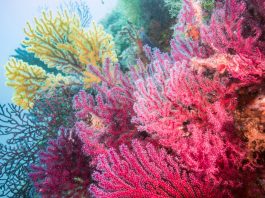A research team from the University of Barcelona have noted that environmental changes, such as those caused by climate warming, can have a deep impact on the sea’s ecosystems.
Thus, it is vital to gather both biological and ecological information, regarding the main species, to predict and mitigate the potential impacts of these changes in the distribution, abundance, and interaction of these sea urchin species.
How was this study conducted?
This study was led by Marta Pascual, lecturer at the Faculty of Biology, a member of the Biodiversity Research Institute (IBRio) at the University of Barcelona, and CSIC research lecturer at the Centre for Advanced Studies of Blanes (CEAB-CSIC), has analysed the genetic structure of a key species in the shallow littoral ecosystems in the Mediterranean: the black sea urchin (scientifically known as Arbacia lixula).
The results, published in the journal Frontiers of Marine Science, confirmed that global warming could have a notable impact on this species, since its population suffer at a higher impact due to salinity rather than temperature.
What does this mean for the black sea urchin population?
According to the research team, this discovery illuminates the potential impacts of climate change in a key ecological species, and indicates the vulnerability of the urchin species known as ‘Paracentrotus lividus.’
“In the Mediterranean, there are mainly two species of sea urchins in the littoral area: the edible species Paracentrotus lividus and the black sea urchin, Arbacia lixula, which we do not eat. These are bioengineer species, since they can shape the ecosystems where they live due to their diets,” commented Creu Palacin, member of the IRBio, and the Department of Evolutionary Biology, Ecology and Environmental Sciences.
The populational structure studies allow researchers to ascertain the level of connectivity between populations and, therefore, the dispersive ability of the species in the studied area. Furthermore, they also allow scientists to establish what environmental variables have a higher influence in this structuration and involve a major challenge of adaptation.
“Studying these adaptation and connectivity processes provides us with an idea of how these species can respond to environmental changes,” explained Carlos Carreras, first author of the article and member of the Department of Genetics, Microbiology and Statistics, and also a member of the IRBio.
What did the genomic analysis reveal?
Scientists conducted a genomic analysis of 240 subjects from eleven different populations of sampled black sea urchins in the Mediterranean coast, spanning from Tarifa to Dalyan. They utilised the genotyping-by-sequencing (GBS) technique, which allowed researchers to analyse a representative part of the genome of each sample, characterise its genotype, and compare it to that of other subjects using different genetic markers.
“Genomic tools are necessary to detect the genetic differentiation in these cases and to identify those environmental variables with a higher influence in the genetic structuration,” said Marta Pascual.
The results from this indicate that there are genetic differences among the populations of the western Mediterranean Sea and the eastern Mediterranean Sea, and that the structuration is mainly determined by the variability of salinity between these two areas, while temperature seems to play a secondary role.
“Moreover, the populations are generally well-connected —except for those between eastern and western Mediterranean areas—which could favour changes in their distribution if the environmental conditions require,” observed researchers.
What can scientists determine regarding the movement of the species?
The data contrasts with the results attained in a previous study by the same research group on the dissemination of the P. lividus urchin, the other most abundant species in the littoral area of the Mediterranean Sea. These species present a more marked structuration, and also, the differences of the populations are determined by the salinity and the temperature.
“This means that the black sea urchin could live better in a global warming scenario, and therefore, could move the P. lividus urchin due to major connectivity among populations. These changes of species could have a great impact on the affected ecosystems due to urchin’s role as engineers,” noted Xavier Turon.
What do researchers intend to do following these results?
The next step in this research is to gain further knowledge regarding the genomic regions that have been detected for both species in this study. With this aim, the UB researchers have developed a project led by the lecturer of the Faculty of Biology Cinta Pergueroles, as part of the call of the Catalan Earth Biogenome project of the Institute for Catalan Studies for the sequencing of the Arbacia lixula genome.
“The model genomes are a fundamental tool, since they allow us to locate the regions that we identify as affected by the environmental variables we analysed, as well as the genes we can find,” concluded the researchers.









